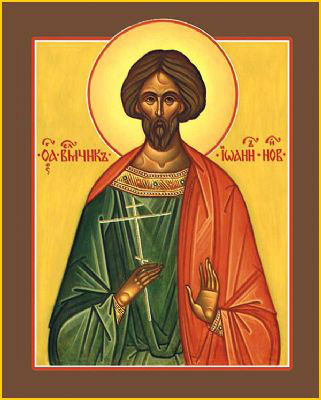The Holy Great Martyr John the New of Suceava, lived in the fourteenth century in the city of Trebizond. He was a merchant, devout and firm in his Orthodoxy, and generous to the poor.
Once, he happened to be sailing on a ship while pursuing his trading activities. The captain of the ship was not Orthodox, but got into an argument about the Faith with St John. Having been vanquished by the saint’s words, the captain resolved to make trouble for him when they got to Cetatea Alba, Moldova (Now – Belgorod-Dnestrovsky, Ukraine). During the ship’s stay at Cetatea Alba, the captain went to the city ruler, a fire-worshipper, and suggested that on his ship was a studious man who also desired to become a fire-worshipper.
The city ruler invited St John to join the fire-worshippers and renounce his faith in Christ.
The saint prayed secretly, calling on the help of Him Who said, “When they shall lead you, and deliver you up, take no thought beforehand what you shall speak, neither do you premeditate; but whatsoever will be given you in that hour, speak that, for it is not you that speaks, but the Holy Spirit” (Mark 13:11). And the Lord gave him the courage and understanding to counter all the claims of the impious and firmly confess himself a Christian. After this, the saint was so fiercely beaten with rods that his entire body was lacerated, and the flesh came off in pieces. The holy martyr thanked God for being found worthy to shed his blood for Him and thereby wash away his sins.
Afterwards they put him in chains and dragged him away to prison. In the morning the city ruler ordered the saint brought forth again. The martyr came before him with a bright and cheerful face. The intrepid martyr absolutely refused to deny Christ, denouncing the governor as a tool of Satan. Then they beat him again with rods, so that all his insides were laid bare.
The gathering crowd could not bear this horrible spectacle and they began to shout angrily, denouncing the governor for tormenting a defenseless man. The governor, having the beating stopped, gave orders to tie the Great Martyr to the tail of a wild horse to drag him by the legs through the streets of the city. Residents of the Jewish quarter particularly scoffed at the martyr and threw stones at him. Finally, someone took a sword and cut off his head.
St John’s body with his severed head lay there until evening, and none of the Christians dared to take him away. By night a luminous pillar was seen over him, and a multitude of burning lamps. Three light-bearing men sang Psalms and censed the body of the saint. One of the Jews, thinking that these were Christians coming to take up the remains of the martyr, grabbed a bow and tried to shoot an arrow at them, but he was restrained by the invisible power of God, and became rigid.
In the morning the vision vanished, but the archer continued to stand motionless. Having told the gathering inhabitants of the city about the vision and what was done to him by the command of God, he was freed from his invisible bonds. Having learned about the occurrence, the ruler gave permission to bury the body of the martyr in the local church. This occurred between the years 1330 and 1340. There is some question about the year of the saint’s martyrdom. St Nicodemus of the Holy Mountain gives the year as 1642, while others say it was 1492.
The captain who had betrayed St John repented of his deed, and decided secretly to convey the relics to his own country, but the saint appeared in a dream to the priest of the church, and prevented this. After seventy years the relics were transferred to Suceava, the capital of the Moldo-Valachian principality, and placed in the cathedral church.
Adapted from OCA.ORG





